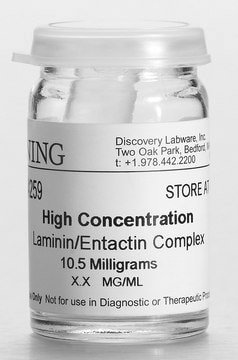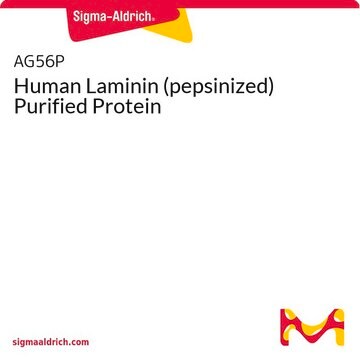SCR127
Synthetic Laminin
Synthetic peptide, powder, suitable for the in vitro culture of rat neural stem cells
About This Item
Recommended Products
product name
Synthetic Laminin Peptide for Rat Neural Stem Cells,
Assay
>95% (HPLC)
Quality Level
form
lyophilized
technique(s)
cell culture | mammalian: suitable
input
sample type neural stem cell(s)
UniProt accession no.
shipped in
dry ice
storage temp.
−20°C
Gene Information
rat ... Lamb2(25473)
General description
To overcome this time barrier, a defined synthetic laminin substrate with similar binding and functional properties of the native laminin protein is considered to be highly advantageous as it would eliminate the requirement to test and screen new lots of native protein. Millipore’s Synthetic Laminin Peptide is a suitable replacement for the native laminin protein, and has been optimized to specifically support cell adhesion, proliferation and multi-lineage differentiation of rat neural stem cells (NSCs) in vitro. Rat neural stem cells grown on tissue culture plates coated with the synthetic laminin peptides display the characteristic neural stem cell markers, Nestin and Sox-2, and furthermore possess the capacity to preferentially differentiate down both glial and neural lineages. Millipore’s Synthetic Laminin Peptide is an inexpensive, reproducible, and defined ECM substrate alternative for the in vitro culture of rat neural stem cells.
(Note: This product has been optimized to support the growth of rat NSCs, and is not recommended for use with human or mouse NSCs).
Packaging
Physical form
Storage and Stability
Legal Information
Disclaimer
Storage Class Code
11 - Combustible Solids
WGK
WGK 3
Flash Point(F)
Not applicable
Flash Point(C)
Not applicable
Certificates of Analysis (COA)
Search for Certificates of Analysis (COA) by entering the products Lot/Batch Number. Lot and Batch Numbers can be found on a product’s label following the words ‘Lot’ or ‘Batch’.
Already Own This Product?
Find documentation for the products that you have recently purchased in the Document Library.
Articles
Frequently asked questions about neural stem cells including NSC derivation, expansion and differentiation.
Protocols
Coating surfaces with laminin for culturing cells requires specific conditions for optimal results. Protocols for coating coverslips to culture neurospheres and general cell culture are included.
This page covers the ECM coating protocols developed for four types of ECMs on Millicell®-CM inserts, Collagen Type 1, Fibronectin, Laminin, and Matrigel.
Our team of scientists has experience in all areas of research including Life Science, Material Science, Chemical Synthesis, Chromatography, Analytical and many others.
Contact Technical Service







